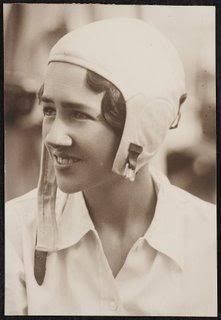 |
| Anne Morrow Lindbergh |
With Charles’ instruction and encouragement, Anne earned a private pilot’s license, and also eventually became the first woman to hold a first-class glider pilot’s license. These feats were unusual, because at the time women didn’t enter into “masculine” pursuits like aviation very often. She served as her husband’s radio operator, navigator and co-pilot on several long flights charting potential routes for commercial airlines. Eventually, Anne was the first woman awarded the National Geographic Society’s Hubbard Medal for her duties as “crew” on two of these survey flights. These flights, in sometimes dangerous conditions in their single-engine airplane over uncharted air space, brought Anne and Charles closer and were some of their happiest times together. (Later in life, Anne received several more awards for her contributions to aviation.)
Anne and Charles had six children, though tragically, their first child, Charles Jr., was kidnapped and killed at the age of 18 months. For many years, Anne felt continually pulled between her roles—her diaries show a constant battle for time and space to write and think, all while raising children and accompanying Charles on many of his flights. As she writes in the introduction of Locked Rooms and Open Doors, “But on the other hand, the trip [an Atlantic survey flight], especially as it was prolonged for five and a half months, separated me from my child [their second son, Jon], the most healing and nourishing element in my life. It also crowded out any possibility of a quiet contemplative coming to terms with grief, for me a necessary inner process, and it meant a long interruption in the work I had just restarted of writing my book [North to the Orient].”
Despite the many demands on her time, Anne produced 13 books, including five volumes of diaries and letters. Her most famous book, Gift From the Sea, a collection of essays about women’s roles, was inspired by a vacation on Florida Captiva Island
Despite a number of serious challenges to their relationship, Anne and Charles remained married until Charles’ death in 1974. Anne continued to write after his death, though she did not publish any more books.
I want to be like Anne Morrow Lindbergh in the sense that I fully enter into life while still retaining a sense of myself and my own work. She was able to move beyond her comfort zone and achieve more than she ever dreamed possible. It encourages me that she felt the same work/family tug of war I do, even though she lived in a different time and under different circumstances. I’m not alone in feeling torn between the needs of my family and my own ambitions.
I recently picked up a lovely copy of Gift From the Sea at my library’s bookstore—I’ll end this post with some of Anne’s words on the topic of solitude taken from it:
“For it is not physical solitude that actually separates one from other men, not physical isolation, but spiritual isolation. It is not the desert island nor the stony wilderness that cuts you off from the people you love. It is the wilderness in the mind, the desert wastes in the heart through which one wanders lost and a stranger. When one is a stranger to oneself then one is estranged from others too. If one is out of touch with oneself, then one cannot touch others…. Only when one is connected to one’s own core is one connected to others, I am beginning to discover. And, for me, the core, the inner spring, can best be refound through solitude.”
If you want to know more about Anne Morrow Lindbergh, check out Kathleen C. Winters’ biography, Anne Morrow Lindbergh: First Lady of the Air, or pick up one of Anne’s collections of diaries and letters.




.jpg)


